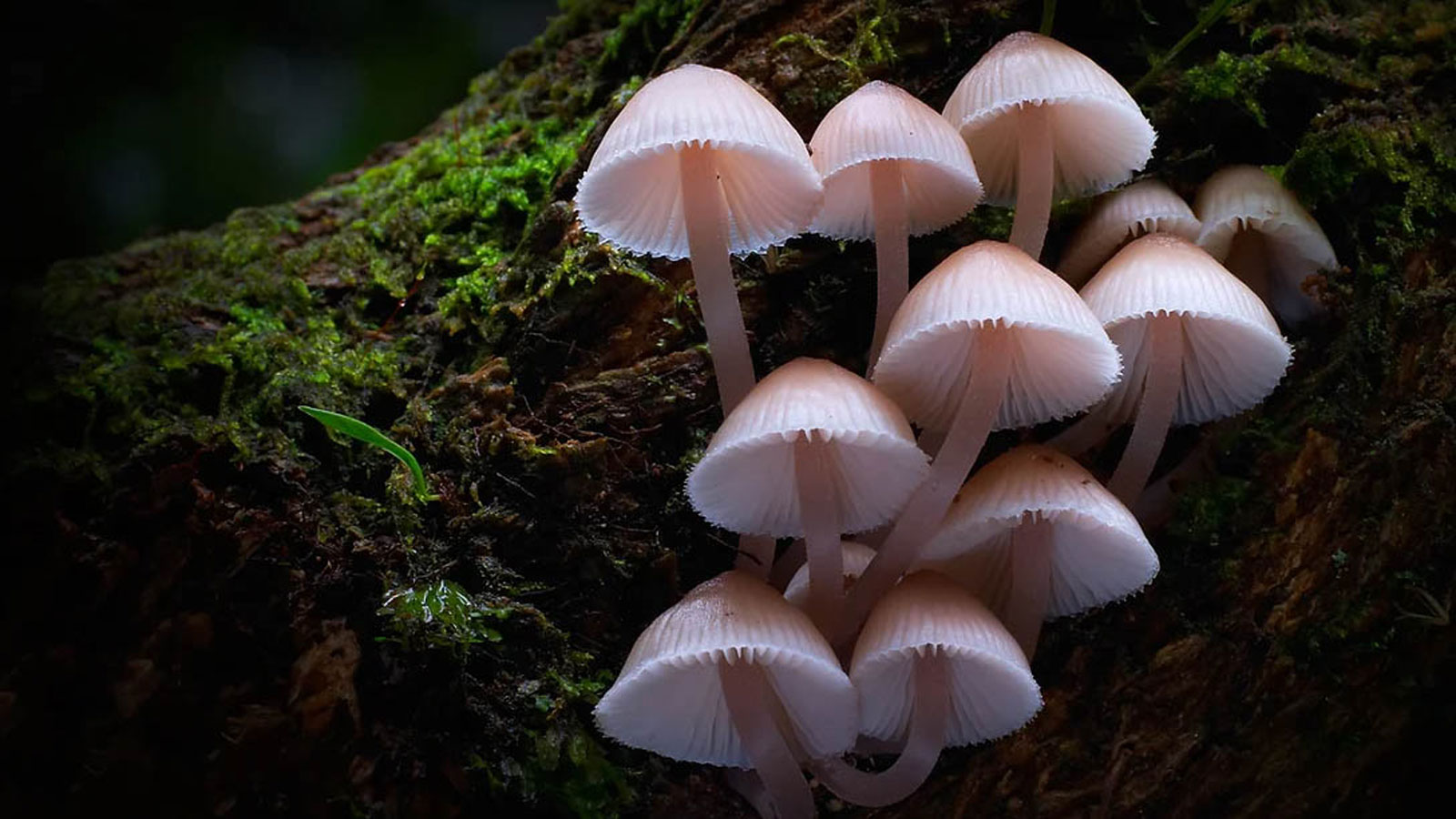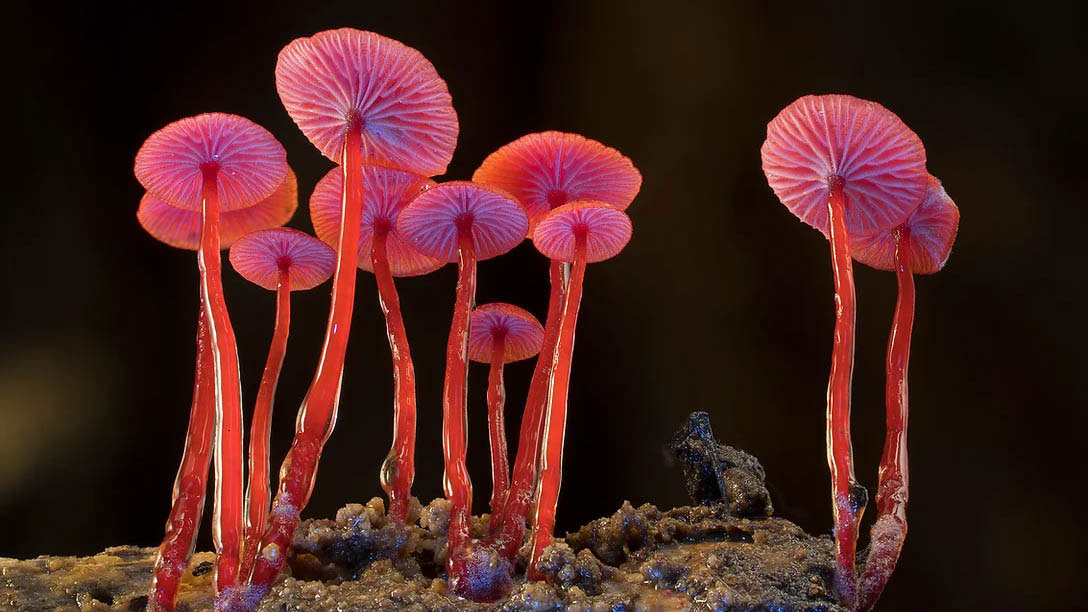Natural Wonders: Stephen Axford and Catherine Marciniak on Fungi: Web of Life

Critics Campus 2024 participant Austin Lancaster speaks to executive producers Stephen Axford and Catherine Marciniak about the process of creating Fungi: Web of Life, a breathtaking document of mycological metamorphosis.
Stephen Axford happened to pick just the right retirement location for a fungi fetishist. For 16 years now, he’s been taking photographs in one of Australia’s fungi hot spots, an endangered lowland subtropical rainforest on the east coast of New South Wales. Axford and his filmmaking partner, director and cinematographer Catherine Marciniak, have gained international renown for their vivid time-lapse recordings of growing mushrooms, featured in various documentaries as well as their own YouTube channel, Planet Fungi. A new 45-minute film, Fungi: Web of Life, directed by Gisela Kaufmann and Joseph Nizeti – Axford and Marciniak are two of the executive producers credited on the project – features their work in IMAX 3D.
“In the early days, it was a bit of a hard sell to commissioning producers,” Marciniak says. “When we said the word ‘fungi’, they would think about the tinea between their toes or the common field mushrooms on their plates. People didn’t really get how biodiverse and important fungi are on the planet.” When Axford talks fungi, you can sense his enthusiasm and affection. He tells me of one of his favourites, a unique blue truffle-like mushroom decorated in a light layer of frost-like mycelium fuzz. “You always assume the mushrooms in your backyard are going to be common old mushrooms,” he says, but not in this case. When I ask what its name is, he informs me that, when he discovered it, it didn’t have one; like more than a few of the species discovered on his long walks, it was new to science. It’s now been christened Coprinopsis pulchricaerulia, also known by the nickname ‘Frosty Blue’.
As Fungi: Web of Life emphasises, a great number of fungi remain undescribed, their uses unexplored. “There’s been a real myco-awakening in the last decade,” Marciniak says, pointing to a renewed scientific and public interest in fungi’s ecological benefits and utility. She praises Fungi: Web of Life’s presenter, Merlin Sheldrake, a young British mycologist and author whose ebullient bestseller work Entangled Life: How Fungi Make Our Worlds, Change Our Minds & Shape Our Futures formed the basis of the film’s script, co-written by Marciniak and Nizeti. “I’ve always loved the poetry that Merlin brings to the topic,” she says, citing a scene from the documentary in which Sheldrake stands in a blackened, recently logged section of Tasmania’s Tarkine rainforest, comparing its ecological loss to the legendary burning of the Library of Alexandria.
The time-lapse sequences in the film are astonishing. The high-definition metamorphoses have a hallucinogenic quality, of a degree more typically associated with the more fertile imaginations within the field of animation. A cluster of moss-green round caps inflate and take on a peachy blush, as the edges lift to reveal a striking set of gills. Bursting out of an egg-like pod, an anemone-shaped stinkhorn displays its reddish arms, which are coated in a chocolate-mousse goo. A crowded thicket of tiny orange mushrooms are engulfed in a foamy mould as they collapse and wither. The forms are amazingly diverse: phallic stems, furry-edged ears, undulating manta ray–like folds and fuzzy tubes that rise like smoke rings.

Fungi: Web of Life
To capture the images, Axford takes pieces of wood with fungi growing on them and puts them in their ‘fungarium’ – a dark, moist environment. A camera is placed to take photos at intervals, a process that sometimes takes days, even weeks. Their first fungarium was built in a shower recess in their home, but now they’ve upgraded to a shipping container. The moment when Sheldrake bends down in the forest to look at the bioluminescent Mycena chlorophos, then, is in fact a bit of smoke and mirrors: in the cut to the close-ups, we jump from Tasmania to Axford and Marciniak’s abode. Axford jokes about the scrunchy sound effects that accompany the growing mushrooms: “The sound effects are good fun, but mushrooms don’t make a lot of noise. I guess that’s something filmmakers like to add! Chu chu chu chu …”
Lending her voice to the film’s narration is none other than Björk, the Icelandic avant-pop pioneer. That this came about was a matter of fortuitous timing: in making her 2022 goblincore album Fossora, Björk drew heavily from the world of fungi for inspiration, placing her prominently in the ranks of non-scientific myco-investigators. Her music isn’t used in the documentary, but Fossora nonetheless makes an apt companion. On the woodsy ‘Fungal City’, bouncing clarinet lines underpin a sweetly sensual ode that draws a metaphor between the life-giving “sunken mystery” of mycelial networks and that of a relationship with a lover. “Her fascination made her the perfect choice of narrator,” says Marciniak. “She brings a very different style to the usual.”
Axford tells me of his travels to the Chinese province of Yunnan, a world-famous fungi-rich location featured in the film. It’s a place brimming with fungiphilia: there are murals and entire cities dedicated to mushrooms, as well as markets and restaurants that specialise only in the ingredient; 900 different species are used for either food or medicine. In comparison to Australia, the population are much more conversant in knowing what kind of fungi can and can’t be eaten. “We tend to be fairly scared of mushrooms,” Axford says, referencing a recent case that has gained infamy across Australia and the world. Despite such morbid tales, Axford hopes that mushrooms might become better known here for their constructive purposes.
Axford and Marciniak have further fungi adventures planned. In November, they will take up an invitation to fly to South Africa and Zambia in order to photograph the world’s largest mushroom, Termitomyces titanicus – massive enough to feed a family for days. Clearly, Axford and Marciniak don’t intend to slow down just yet. Spurred on by their joint mission of discovery and education, both agree: “Fungi has changed the course of our lives.”